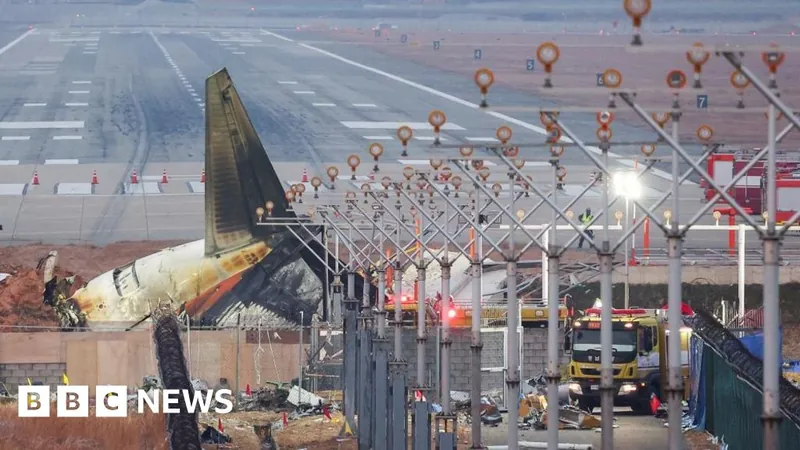
Shocking Details Emerge About South Korea's Devastating Plane Crash: What’s the Deal with That Concrete Wall?
2024-12-30
Author: Kai
Introduction
A horrifying plane crash at Muan International Airport in South Korea has left 179 people dead, and investigators are now raising critical questions about a concrete wall situated perilously close to the runway, which may have exacerbated the disaster.
Eyewitness Accounts
Eyewitness footage captures the tragic moments of a Jeju Air flight as it veered off the runway and collided with this unusual 4-meter-high concrete structure, igniting a catastrophic fireball. Aviation safety experts believe that if this wall had not been present, the outcome may have been drastically different, with most passengers potentially surviving the incident.
Investigation Insights
The pilot of the aircraft reported encountering a bird strike, prompting an emergency landing attempt from an unusual direction. The jet landed approximately 2,800 meters down the runway, seemingly without deploying its landing gear or wings. David Learmount, an air safety expert, stated that the disaster resulted from the collision with the wall rather than the landing itself. He emphasized that while the landing was not ideal, it may not have led to such a fatal outcome without the obstruction.
Controversy Surrounding the Wall
Adding to the controversy, pilot Christian Beckert commented on the peculiar nature of the wall, asserting that concrete structures are rarely found at the end of runways, typically due to safety regulations aimed at mitigating crash risks. South Korea's Yonhap News Agency indicated that the wall is home to a localizer navigation system, designed to guide aircraft during landings, but questioned whether it should have been constructed from a more forgiving material.
Potential Regulatory Changes
In light of this incident, South Korea's transport ministry is now evaluating whether current regulations regarding runway obstacles may require an overhaul. Current safety standards stipulate that structures within a specified distance of runways are meant to be frangible, breaking apart upon impact to mitigate damages during emergencies. Chris Kingswood, a veteran pilot, underscored the precarious nature of aircraft design, which prioritizes lightweight structures at the expense of durability during belly landings. This design flaw can have catastrophic consequences if the aircraft strikes a rigid object.
Pilot Awareness
The incident has raised questions about pilot awareness of the wall's presence, particularly since the landing approach was atypical. Aviation analyst Sally Gethin indicated that the investigation into black box recordings may provide crucial answers regarding communication between the pilots and air traffic control leading up to the disaster.
Conclusion
As the investigation continues, experts and families of the victims are left with many unanswered questions about how a seemingly minor obstacle could lead to such a tragic outcome. Should airport regulations evolve to prevent similar disasters in the future? The fallout from this heart-wrenching event is likely to be felt for years as the aviation community grapples with the implications of the findings. Stay tuned for ongoing updates on this evolving story.



 Brasil (PT)
Brasil (PT)
 Canada (EN)
Canada (EN)
 Chile (ES)
Chile (ES)
 Česko (CS)
Česko (CS)
 대한민국 (KO)
대한민국 (KO)
 España (ES)
España (ES)
 France (FR)
France (FR)
 Hong Kong (EN)
Hong Kong (EN)
 Italia (IT)
Italia (IT)
 日本 (JA)
日本 (JA)
 Magyarország (HU)
Magyarország (HU)
 Norge (NO)
Norge (NO)
 Polska (PL)
Polska (PL)
 Schweiz (DE)
Schweiz (DE)
 Singapore (EN)
Singapore (EN)
 Sverige (SV)
Sverige (SV)
 Suomi (FI)
Suomi (FI)
 Türkiye (TR)
Türkiye (TR)
 الإمارات العربية المتحدة (AR)
الإمارات العربية المتحدة (AR)